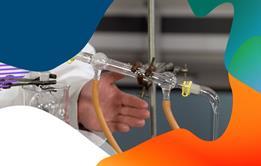Learn to determine the enthalpy change of a reaction either directly or indirectly using Hess’s Law
The enthalpy change of a reaction is the energy change that takes place during a reaction per one mole of substance under standard temperature and pressure. Enthalpy changes are normally reported in kJ mol-1.
Teaching enthalpy change at 14–16 too? Watch the practical video to show learners how to measure and evaluate the combustion of alcohols using spirit burners. Plus, download the resources for teacher and technician notes, follow-up worksheets and more.
The enthalpy of neutralisation is fairly straightforward to measure as demonstrated in this video from Malmesbury Education. The enthalpy of neutralisation is defined as the enthalpy change when one mole of water forms from one mole of H+(aq) ions and one mole of OH- (aq) ions under standard temperature and pressure. Please note in the following video: the calculations and answers are correct, although the specific heat capacity of water is incorrectly written as 4.18 J/kg/°C rather than 4.18 J/g/°C.
Questions you can ask your students:
- Why is the temperature change less than the enthalpy change might predict?
- Why don’t you take a temperature measurement when the acid and base are mixed?
This experiment requires students to graphically represent their results and interpret them. To calculate the enthalpy change, students need to ‘extend’ the line of best fit beyond the time at which the reactants were added together and read off the change in temperature from the graph. When calculating the enthalpy change, students need to ensure that they are reporting the enthalpy change ‘per mole’ rather than in absolute terms.
The following video by SpaceyScience highlights an experimental method to determine the enthalpy change for the reaction:
MgO (s) + CO2 (g) → MgCO3 (s)
<<Spacey Science content no longer available so this has been taken out for now>>
It’s not always possible to measure the enthalpy change for a specific reaction, but Hess’s Law states that the enthalpy change for a chemical reaction is independent of the route taken. Determining the enthalpy changes for the reaction of MgO and MgCO3 with HCl respectively enables students to determine the enthalpy change for ΔH1 using:
ΔH1 = ΔH3 – ΔH2
There are a number of videos available online which do a good job of explaining the method, but are unreliable when it comes to the calculations. Many of the errors are very similar to the errors that will be made by students and you might want to use them as a teaching aid. Crucially, it’s common for exothermic and endothermic reactions to be reported incorrectly. Exothermic reactions should be reported as negative enthalpy changes and endothermic reactions should be reported as positive enthalpy changes. In addition, many common mistakes arise from the failure to convert enthalpy changes into kJ mol-1.
A final enthalpy change experiment involves determining the enthalpy change of combustion. In this experiment, a known quantity of fuel is burnt as it heats up a known quantity of water. The temperature change can be used to calculate the enthalpy change of combustion.
Questions you can ask your students:
- Why will the enthalpy change of combustion be greater than your calculation?
- Why must the spirit burner be left to cool before the mass is remeasured?
- What is the black ‘soot’ on the bottom of the conical flask? How does this affect the reliability of the enthalpy change you have calculated?
Students should consider sources of error in this experiment. Some water may be lost as water vapour to the atmosphere, and the heat from the spirit burner is being used to heat the conical flask as well as the surrounding air, so not all heat is directly transferred into the water. It’s important to measure the mass of the spirit burner as soon as it is safe to do so, as some vapour will be lost to the atmosphere as the burner cools.
Also check out…
- Introduce or revise this topic with our practical video and supporting resources for 14–16 learners Enthalpy change of combustion.
- This CPD article Teaching enthalpy cycles at post-16 offers teaching strategies to help learners get to grips with thermodynamics, including enthalpy changes and Hess’s law.
- Measuring enthalpy changes: teaching tips for your classroom offers suggestions for probing your students’ understanding and reflects on classroom demonstrations and experiments.
- Help students evaluate experiments – this resource provides an approach for getting students to think critically about the experimental methods they are using.
- Help students understand accuracy and error – looks at ideas and ways to help students to fully appreciate the source of experimental error and what we mean by accuracy.
Additional information
We have collated these videos of key practical experiments to support remote teaching as part of our response to Covid-19. Teachers requested resources to help them deliver practical content without access to laboratories or equipment. We are developing further resources and welcome feedback to help us produce those you most need. Please email us or use the comment section below.
Practical videos | 16–18 years

Videos of key practical techniques and apparatus for revision, flipped learning or remote teaching
- 1
- 2
- 3
- 4
- 5
- 6
- 7
- 8
 Currently
reading
Currently
reading
Enthalpy change determination
- 10
- 11
- 12
- 13











































1 Reader's comment